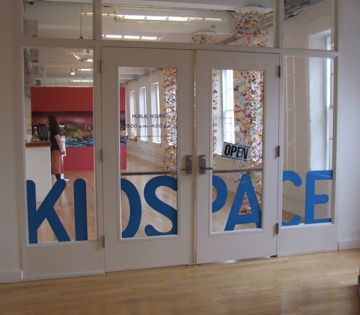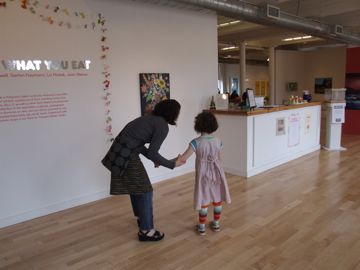On March 20, Kidspace at MASS MoCA celebrated its 10th anniversary. Kidspace, a contemporary art gallery, studio, and educational program, promotes the understanding and teaching of art through experiential learning opportunities designed for elementary and middle school students, teachers, and families. Housed at MASS MoCA in North Adams, Massachusetts, Kidspace is a collaborative program founded in 2000 by the Williams College Museum of Art (WCMA), the Sterling & Francine Clark Art Institute (The Clark), and MASS MoCA. Kidspace is designed to serve as a partnering mechanism between the three museums and six rural schools in the North Berkshires, and annually provides every student in Pre-K through 8th grade with sequential arts education opportunities. The partnership involves teachers, administrators, and three museum staff in the development and assessment of programs.
Leading up to the big 10th anniversary celebration, I had the chance to talk with Laura Thompson, Director of Exhibitions and Education at Kidspace, about what makes Kidspace a different kind of experience for students.
Joe Fusaro: First of all, congratulations on the 10th anniversary of Kidspace. Tell me about the kinds of thematic exhibits Kidspace has organized since 2000. What are some of your personal favorites? And how does Kidspace come up with the themes?
Laura Thompson: Over the past 10 years, Kidspace has organized 20 exhibitions representing a diversity of themes. We have organized exhibitions about the natural environment, childhood fears, food, and music. The variety of art materials represented in our exhibitions range from grass and pompoms to welded metal and phone books. Some of my personal favorites were the following exhibitions: Nature Park with Victoria Palermo’s grass chairs and rubber trees and Rob De Mar’s miniature three-dimensional landscapes. I loved this exhibit because we were able to talk about how artists either use natural materials as artistic medium or represent the natural environment in their work. I also loved Long-Bin Chen’s Reading Sculpture exhibition, which featured Buddha heads and sculptures of warriors made out of phone and text books. This was a fun exhibit to talk about recycling and make connections between literature and the visual arts.
Kidspace comes up with the themes of the exhibitions by having a deep connection to the schools. We are aware of topics that are being addressed in the schools and try to select themes that illustrate these topics “thinking outside the box,” using visual arts as a means for encouraging discussions. We sometimes choose topics that are not being addressed in the schools like childhood fears (what did the exhibit on childhood fears look and sound like?) or about the wars in Iraq and Afghanistan, offering a place for these important discussions to take place.
JF: What was the inspiration for starting Kidspace? Were there any particular hurdles you encountered starting the space ten years ago?
LT: I have been working for Kidspace since 2002, and therefore, my knowledge about the inspiration in starting up the gallery is based on what I have been told. In 2000, WCMA’s past education director, Barbara Robertson, wanted to take on a new challenge and wanted to reach out to the North Adams community. She also saw that MASS MoCA was starting up but would be without an education program. WCMA’s education director got the three museum directors (The Clark, WCMA, and MASS MoCA) to form a consortium that oversees Kidspace, housed at MASS MoCA. Each of the three museums contribute in-kind aspects like staff time and space, and each has the responsibility of raising funds to support everything we do from artist residencies to the buses for school groups.
The hurdles I suppose would have been regarding funding. As soon as we became established in MASS MoCA, we did not have any problems with securing artists for our exhibitions. Rather, we found it difficult and continue to find it tricky, especially in today’s economy, to fund all our different programs. The key thing for people to understand is that Kidspace depends on grants and donations to make the magic happen here.
JF: Tell me more about your relationship with the public schools in North Adams and the surrounding towns. How do students take advantage of what you have to offer?
LT: We have a solid relationship with the public schools in North Adams and the North Berkshires. We have been working with them since 2000 and every student in 6 schools visits Kidspace and the three museums annually. Continuity is key in Kidspace; each year’s programming builds on the previous year. Students who were in kindergarten when the gallery first opened, and now are in eighth grade, have experienced nine years of arts education.
JF: So the key thing to understand here is that Kidspace reaches out into the community vs. relying on schools calling and saying they want a tour.
LT: Right. Kidspace is part of the life of every elementary schoolchild and teacher in North Adams, Clarksburg, Florida, and Savoy, Massachusetts. Through its partnership with local public schools, Kidspace introduces children to contemporary art and integrates the study of art with the general curriculum. During class visits to the space, students work with Kidspace staff to interpret the art on view and respond to the exhibition themes through their own artistic production.
Students also work with their teachers in the classroom on projects outlined in a curriculum guide that accompanies each exhibition. Additional partnerships are formed with local organizations that help support learning in the schools and connect to themes being explored in Kidspace programs, including Williams College, Inkberry, Massachusetts College of Liberal Arts, the Center for Ecological Technology, and Greylock Arts.
With funding from the Massachusetts Cultural Council Creative Schools grant, Kidspace organizes an extensive artist residency program with the professional artists who are featured in Kidspace exhibitions. These artists visit the six public schools to work with students on art projects using materials and artistic processes similar to their own. Additional visits with the artists often take place at Kidspace, where students can have a second opportunity to explore the Kidspace exhibition—this time with the artists who created the work on display. And when possible, Kidspace brings in local artists and writers to also conduct residency programs relating to themes in Kidspace exhibits.
Students also visit one or more of the three collaborating museums (WCMA, the Clark, or MASS MoCA) as part of the Kidspace Three-Museum Semester. These visits enable teachers and students to continue to hone their art-viewing and interpreting skills while examining the diverse collections and exhibitions in the different museums….
Stay tuned for part two of my interview with Laura Thompson next week in Teaching with Contemporary Art.






Pingback: Talking with Laura Thompson at MASS MoCA’s Kidspace, Part 2 | Art21 Blog
Pingback: MASS MoCA - Blog - Art21 and Kidspace